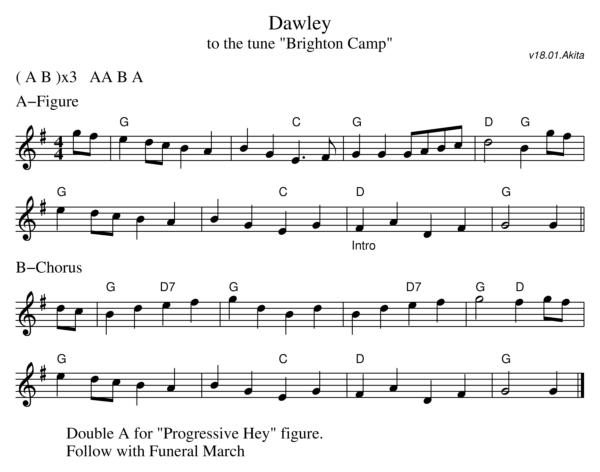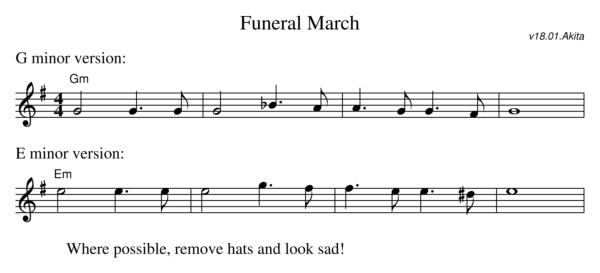Dawley is notable as the birthplace of Captain Webb, the first man to swim the channel. It is a small town in the borough of Telford, Shropshire.
This dance was originally learnt at a workshop run by Roy Dommett.
He was doing morris research in the Vaughn Williams Memorial Library, back in the early 1960s, when he was recommended to visit a woman who lived in Telford.
Most of the dances the woman talked about had been danced by 8–10 people, but this one had been used when they were short of dancers as it only needed five people.
Historically, it would have been danced with short sticks as they allowed fast, precise moves. The costume worn by the Dawley dancers was not tatters, but a shirt with crotal bells sewn onto it. For the uninitiated, crotal bells are round bells made of pewter or copper with a metal ball inside.
The dance given here is largely as Roy taught it with only one real change. The final figure as taught simply had number 5 go to the back of the set and be picked up by the other dancers to be carried off. We felt that there ought to be a reason for him to be carried off, so we added the rest of the figure that is shown below.
After doing a lot of hunting for more details on this dance, it seems likely that all/most of it was a recreation by Dommett based on the little surviving information that he had, rather than being an accurate reproduction of the original dance.
The Music
During the carry off in the final figure, the opening bars of the funeral march is played.
Instructions
This is a dance for five people. Numbers 1-4 are arranged in a square in the usual manner. Number 5 stands at the front of the set, forming a triangle with 1 and 2.
Number 5 acts rather like a fool in this dance, often going through or around the other dancers. We've chosen to emphasise the fool aspect by making him visually different and giving him a different stick.
It will be helpful if dancers 1 and 2 are a similar height, likewise dancers 3 and 4.
| Figure | Music | |
|---|---|---|
| Rounds | A | |
| Chorus | B | |
| Star | A | |
| Chorus | B | |
| Rights and Lefts Through | A | |
| Chorus | B | |
| Progressive Hey | AA | |
| Chorus | B | |
| Finish | A |
Rounds (A) |
|
|---|---|
| Count | Moves |
| 1-16 | The dancers come on in a line led by number 1 (order is 1, 3, 4, 2, 5), and dance round clockwise. Number 1 will lower his stick and point it at the centre when he starts to form the circle. The other dancers will lower their sticks in turn, one by one, on successive beats. Go round the circle twice if there’s enough time. All finish in place. |
Chorus (B) |
|
|---|---|
| Count | Moves |
| 1-8 | Number 5 starts off a three man hey with 1 and 3. Meanwhile, 2 and 4 turn clockwise to face and strike forehand, then backhand and continuing to alternate, they do a six more stick strikes (so eight in total), stepping continuously. |
| 9-16 | Number 5 switches to a three man hey with 2 and 4. 1 and 3, back in place, turn clockwise to face and strike forehand, then backhand and continuing to alternate, they do a six more stick strikes (again, eight in total), stepping continuously. |
Star (A) |
|
|---|---|
| Count | Moves |
| 1-16 | The four main dancers form a left hand star. Number 5 dances round them clockwise. |
Chorus (B)
Rights and Lefts Through (A) |
|
|---|---|
| Count | Moves |
| 1-4 | The four main dancers pass right shoulder with their partners to change places. Two steps to cross, two steps to turn on the spot. The instant they have passed in the middle, number 5 goes up the centre of the set and turns right to go clockwise around number 4. |
| 5-8 | The four main dancers change places on the side of the dance, passing left shoulders. The instant they have passed on the sides, number 5 goes across the set and turns right to go clockwise around number 1. |
| 9-12 | The four main dancers pass right shoulder with their partners to change places. The instant they have passed in the middle, number 5 goes back down the centre of the set and turns right to go clockwise around number 4. |
| 13-16 | The four main dancers change places on the side of the dance, passing left shoulders to return to place. Number 5 returns to place. |
Chorus (B)
Progressive Hey (AA) |
|
|---|---|
| The call for this figure is often "Progressive Hey, Double A" to help remind the band that the double A is required. | |
| Count | Moves |
| 1-2, 3-4, 5-6, 7-8 |
In the order 1, 2, 3, 4, the dancers take it in turns over two beats to dance into the centre of the set and form a line facing forward, squire’s side standing in front of their partners. Number 5, who will already be in the correct position, stands facing the other dancers. |
| 9-30 | Progressive hey, started off by number 5 passing right shoulders with number 1. Each dancer joins in the reel as number 5 reaches him. Remember to take a couple of steps when turning at each end of the set. Continue the hay until everyone is back in place for the second time. Dancers at the front of the set will finish before those at the back. Remain in line until everyone has finished. |
| 31-32 | Everyone takes two steps facing forward (except number 5 who will be in the right place facing down the set), and two steps back to place. |
Chorus (B)
Finish (A) |
|
|---|---|
| No stepping. This figure is walked. | |
| Count | Moves |
| 1-2 | 1 and 2 make an arch with their sticks crossed and number 5 goes under. |
| 3-4 | 3 and 4 make an arch with their sticks crossed and number 5 goes under. |
| 5-8 | 5 heads way out the back of the set. |
| 9-12 | Dancers 3 and 4 lower their (still crossed) sticks to head height. As 5 comes back towards the set he bumps his forehead into the sticks. |
| 13-16 | 5 does a dramatic stagger, drops their stick, and drapes his arms around 3 and 4’s shoulders for support. |
| The musicians stop playing. 5 holds their body stiff and straight as 3 and 4 lift 5's shoulders while 1 and 2 lift the hips/knees. Number 4 will need to grab 5's hat before it falls off and place it onto his chest. Dancers hold 5 as high as possible, carrying him off while the band plays the funeral march. |
|





